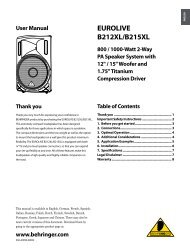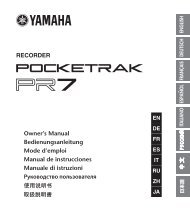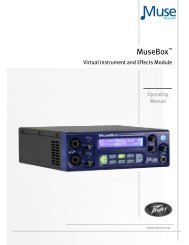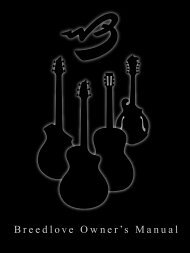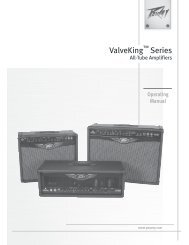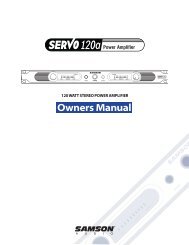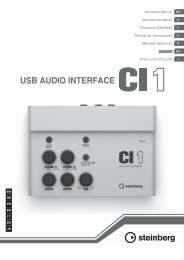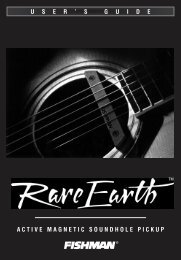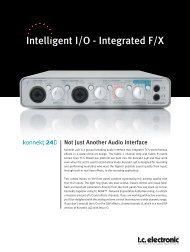understanding, customizing, and hot-rodding ... - Suono Elettronico
understanding, customizing, and hot-rodding ... - Suono Elettronico
understanding, customizing, and hot-rodding ... - Suono Elettronico
You also want an ePaper? Increase the reach of your titles
YUMPU automatically turns print PDFs into web optimized ePapers that Google loves.
antenna lowers the voltage; the meter should<br />
read about minus 12 volts when your h<strong>and</strong> is<br />
two or three inches from the volume antenna.<br />
This completes the tuning of the Volume Oscillator.<br />
In performance, the exact volume tuning is achieved<br />
by adjusting the Volume Tuning control.<br />
B. Adjusting L11 without a voltmeter: Remove<br />
the temporary shorting connection across C28.<br />
Install the volume antenna. Position your Etherwave<br />
so that the volume antenna is at least a foot from<br />
furniture <strong>and</strong> other large objects. Follow these steps<br />
to adjust L11:<br />
1. Set the VOLUME knob to its mid position.<br />
2. Carefully turn the slug in L11 counterclockwise<br />
until it is out as far as it will go. Then turn on<br />
your amplifier <strong>and</strong> set its volume control so that<br />
the theremin tone will be audible but soft.<br />
3. Slowly turn the slug clockwise. At some point<br />
you will hear the theremin tone. As you turn the<br />
slug in L11, the tone will get louder, reach a<br />
maximum loudness, <strong>and</strong> then get softer. Turn the<br />
slug back to the maximum loudness, <strong>and</strong> notice<br />
how loud the tone is.<br />
4. Slowly turn the slug counterclockwise until the<br />
tone is about half its maximum loudness. You<br />
should then notice that bringing your h<strong>and</strong> near<br />
the volume antenna lowers the volume, <strong>and</strong> the<br />
tone is complete silent when your h<strong>and</strong> is two or<br />
three inches from the volume antenna.<br />
This completes the tuning of the Volume Oscillator.<br />
In performance, the exact volume tuning is achieved<br />
by adjusting the Volume Tuning control.<br />
WHY IS THE POWER ADAPTOR<br />
GROUNDED?<br />
In order for any h<strong>and</strong>-capacitance device to work<br />
properly, there has to be a good path for high<br />
frequency currents to flow to ground. Older vacuum<br />
tube theremins used large power transformers, <strong>and</strong><br />
these provided high frequency ground paths because<br />
of the large capacitances between windings.<br />
Transistor theremins use much less power than their<br />
vacuum-tube ancestors, <strong>and</strong> their power transformers<br />
are therefore much smaller. Under certain<br />
conditions, a supplementary ground path is needed<br />
for stable operation <strong>and</strong> good tone color. For this<br />
reason, the power adaptor that is supplied with your<br />
Etherwave provides a direct connection to ground.<br />
That is the purpose of the third prong on the power<br />
adaptor.<br />
If you are using your Etherwave with an amplifier<br />
that also has a direct connection to ground (i.e. a<br />
three-prong power plug), you may experience a<br />
small amount of hum from the ground loop,-<br />
especially if your amplifier is plugged in to a<br />
different power circuit than your Etherwave. If this<br />
happens, simply use a 'ground-lifter' 3-prong-to-2-<br />
prong adaptor on your Etherwave power adaptor.<br />
CAN I USE BATTERY POWER?<br />
Your Etherwave must be grounded somehow. If you<br />
want to battery-power your Etherwave while it is<br />
connected to headphones, or to an ungrounded<br />
battery-powered amplifier, you must provide a<br />
connection to ground or to some sort of a large<br />
metallic structure like a steel building frame or<br />
plumbing system.<br />
If you use batteries, you must supply between 15<br />
<strong>and</strong> 25 volts to each of the Etherwave's power<br />
regulators. Apply the positive voltage to the (+) side<br />
of C19 on the Etherwave circuit board, the negative<br />
voltage to the (-) side of C20, <strong>and</strong> the common to<br />
ground. A double-pole switch may be used to turn<br />
on the batteries. Figure 5 shows how to hook four 9-<br />
volt batteries to power your Etherwave in the<br />
absence of regular AC power. Keep in mind that the<br />
Etherwave draws about 30 milliamperes, so a set of<br />
four regular 9-volt batteries will last for only a few<br />
hours.<br />
Figure 5 - Battery power circuit for the Etherwave<br />
UNDERSTANDING, CUSTOMIZING, AND HOT-RODDING YOUR ETHERWAVE - PAGE 8



